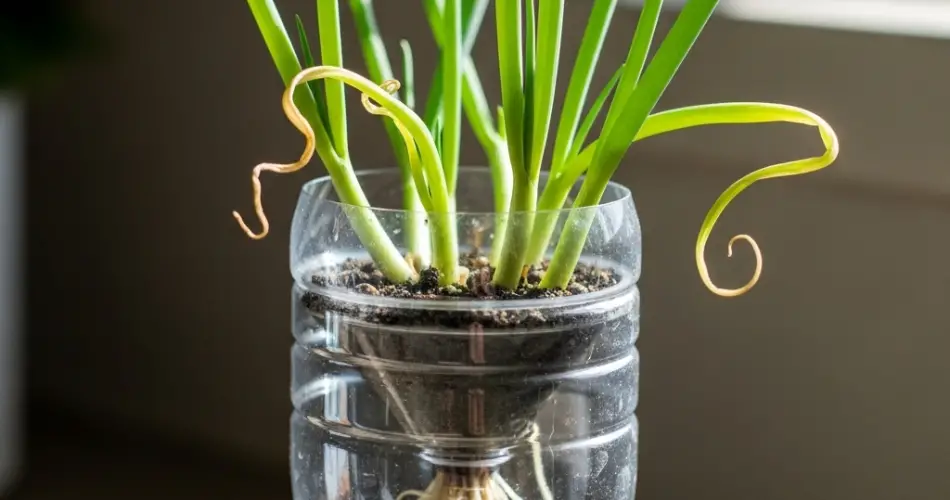Scallions, also known as green onions or spring onions, are a staple in many kitchens thanks to their mild, fresh flavor. They can be added to soups, salads, stir-fries, and countless other dishes to bring a burst of freshness. The good news is you don’t need a garden to grow them—just a few used plastic bottles, some soil, and a sunny spot in your home. This simple, low-cost method allows you to regrow scallions quickly, ensuring you always have a fresh supply at hand.
Why Use Plastic Bottles for Scallion Regrowth?
Regrowing scallions in recycled bottles is a great example of sustainable, space-saving gardening. Not only are you reusing plastic that might otherwise be discarded, but you’re also creating an indoor growing setup that fits in even the smallest kitchens. This method works well for:
-
Apartment dwellers with no outdoor space
-
Busy people looking for low-maintenance plants
-
Anyone interested in reducing kitchen waste
-
Year-round home gardeners
Materials You’ll Need
-
Empty plastic bottles (1–2 liters)
-
A sharp knife or scissors
-
Potting soil or a well-draining soil mix
-
Scallion bulbs (store-bought or leftover from cooking)
-
Watering can or spray bottle
-
A sunny windowsill or well-lit indoor area
Step-by-Step Instructions
1. Prepare the Bottles
Clean the bottles thoroughly to remove any residue. Cut the top third off the bottle using sharp scissors or a craft knife. The bottom portion will act as your planting container. You can also cut side openings if you want to plant multiple scallions in one bottle.
2. Create Drainage
Punch a few small holes in the bottom of the bottle to let excess water escape. Good drainage is essential to prevent root rot.
3. Add Soil
Fill the bottle with potting soil, leaving about 2–3 cm of space at the top. Choose soil that holds moisture but drains well.
4. Prepare and Plant the Scallions
Trim scallions so that you have the white bulb with roots intact. Insert the bulbs into the soil, root side down, and cover lightly. Leave the green tops sticking out above the soil.
5. Water Gently
Moisten the soil without soaking it. A spray bottle works well for even watering, especially in the early days of growth.
6. Place in a Bright Location
Set the bottle on a sunny windowsill or under grow lights. Scallions prefer bright, indirect sunlight for healthy, quick regrowth.
Caring for Your Bottle-Grown Scallions
-
Watering: Keep the soil evenly moist but not waterlogged. Overwatering can cause the roots to rot.
-
Feeding: Apply a diluted liquid fertilizer every 2–3 weeks to encourage lush green growth.
-
Harvesting: When the greens reach about 15–20 cm, snip them just above the bulb. They will regrow several times before needing replacement.
Maximizing Growth and Harvest
To keep your scallion supply constant:
-
Plant in batches a week or two apart so you always have fresh stalks ready.
-
Rotate bottles every few days to ensure all sides get equal light.
-
Replace older bulbs with new ones to maintain strong growth.
-
Avoid overcrowding, as scallions grow best with a little space around them.
Troubleshooting Common Problems
-
Yellowing leaves: Often caused by lack of sunlight or too much water. Move to a brighter spot and reduce watering.
-
Slow growth: Increase light exposure or add a small amount of fertilizer.
-
Mold on soil: Reduce moisture and improve airflow around the bottles.
Benefits of Regrowing Scallions in Bottles
-
Cost-effective: Extend the life of store-bought scallions, reducing grocery bills.
-
Eco-friendly: Reuses plastic bottles, cutting down on waste.
-
Compact: Fits easily on a kitchen counter or windowsill.
-
Fast results: You can harvest your first regrown scallions within a week or two.
From Kitchen Scrap to Fresh Ingredient
This method turns something you might normally throw away—the root ends of scallions—into a continuous source of fresh greens. Whenever you need scallions for cooking, simply snip off what you need and let the rest continue to grow. Over time, you’ll notice how satisfying it is to harvest straight from your windowsill, knowing you grew it yourself.
By using recycled plastic bottles, you’re not just gardening—you’re making an eco-friendly choice that benefits both your home and the planet. With minimal effort and almost no cost, quick scallion regrowth is a practical way to keep your kitchen stocked with fresh flavor all year round.



